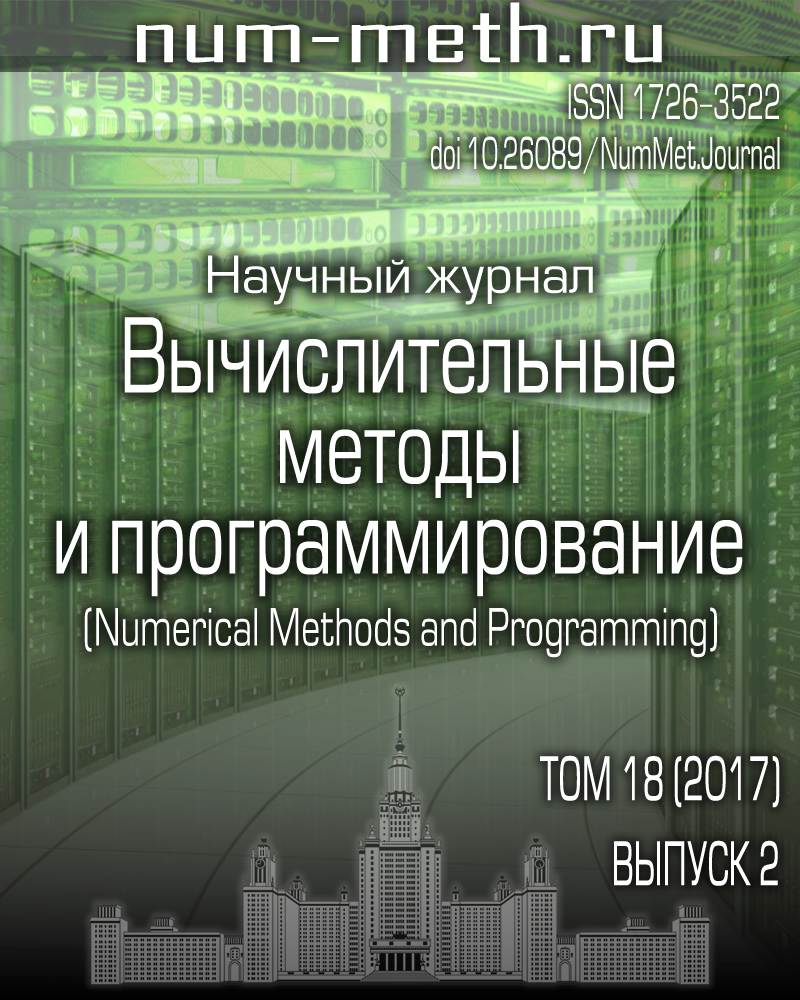DOI: https://doi.org/10.26089/NumMet.v18r210
Новый метод решения задачи томографии при наличии непрозрачного включения
Ключевые слова:
двумерная томография
непрозрачное включение
условие Кавальери
Аннотация
Разработан новый метод реконструкции изображения сечения объекта, содержащего непрозрачное включение. Для того чтобы оценить неизвестные данные в области тени, решается система линейных алгебраических уравнений, построенная на основе представления моментов проекций однородными полиномами. По результатам проведенного вычислительного эксперимента оказалось, что метод имеет преимущества перед альтернативными подходами.
Опубликован
2017-03-27
Выпуск
Раздел
Раздел 1. Вычислительные методы и приложения
Библиографические ссылки
- Ch. M. Ziegler, M. Franetzki, T. Denig, et al., “Digital Tomosynthesis - Experiences with a New Imaging Device for the Dental Field,” Clin. Oral Invest. 7 (1), 41-45 (2003).
- V. Van der Linden, E. Van de Casteele, M. S. Thomas, et al., “Analysis of Micro Computed Tomography Images; A Look Inside Historic Enamelled Metal Objects,” Appl. Phys. A 98 (2), 385-392 (2010).
- V. V. Pikalov and N. G. Preobrazhenskii, Reconstructive Tomography in Gas Dynamics and Plasma Physics (Nauka, Novosibirsk, 1987) [in Russian].
- A. V. Likhachev and V. V. Pikalov, “Three-Dimensional Tomography in Gas Flow Diagnostics in the Presence of an Opaque Body,” Zh. Prikl. Mekh. Tekh. Fiz. 39 (1), 174-180 (1998) [J. Appl. Mech. Tech. Phys. 39 (1), 152-157 (1998)].
- G. T. Herman, Image Reconstruction from Projections. The Fundamentals of Computerized Tomography (Academic, New York, 1980; Mir, Moscow, 1983).
- F. Natterer, The Mathematics of Computerized Tomography (Wiley, New York, 1986; Mir, Moscow, 1990).
- G. H. Glover and N. J. Pelc, “An Algorithm for the Reduction of Metal Clip Artifacts in CT Reconstructions,” Med. Phys. 8 (6), 799-807 (1981).
- B. P. Medoff, W. R. Brody, M. Nassi, and A. Macovski, “Iterative Convolution Backprojection Algorithms for Image Reconstruction from Limited Data,” J. Opt. Soc. Amer. 73 (11), 1493-1500 (1983).
- W. A. Kalender, R. Hebel, and J. Ebersberger, “Reduction of CT Artifacts Caused by Metallic Implants,” Radiology 164 (2), 576-577 (1987).
- G. Wang, D. L. Snyder, J. A. O’Sullivan, and M. W. Vannier, “Iterative Deblurring for CT Metal Artifact Reduction,” IEEE Trans. Med. Imag. 15 (5), 657-664 (1996).
- D. D. Robertson, J. Yuan, G. Wang, and M. W. Vannier, “Total Hip Prosthesis Metal-Artifact Suppression Using Iterative Deblurring Reconstruction,” J. Comput. Assist. Tomogr. 21 (2), 293-298 (1997).
- S. Zhao, D. D. Robertson, G. Wang, et al., “X-Ray CT Metal Artifact Reduction Using Wavelets: An Application for Imaging Total Hip Prostheses,” IEEE Trans. Med. Imag. 19 (12), 1238-1247 (2000).
- J. L. Prince and A. S. Willsky, “Constrained Sinogram Restoration for Limited-Angle Tomography,” Opt. Eng. 29 (5), 535-544 (1990).
- N. V. Vazhenceva and A. V. Likhachov, “Comparison of Limited-Angle Tomography Algorithms Based on the Cavalieri Condition,” Avtometriya 48 (6), 35-45 (2012) [Optoelectron., Instrum. Data Process. 48 (6), 565-573 (2012)].
- A. V. Likhachov, “Use of the Cavalieri Conditions in Region-of-Interest Tomography,” Avtometriya 51 (4), 53-61 (2015) [Optoelectron., Instrum. Data Process. 51 (4), 364-371 (2015)].
- S. Helgason, The Radon Transform (Birkh854user, Basel, 1980; Mir, Moscow, 1983).
- I. M. Gelfand, S. G. Gindikin, and M. I. Graev, Selected Problems of Integral Geometry (Dobrosvet, Moscow, 2000) [in Russian].
Лицензия
Copyright (c) 2017 Вычислительные методы и программирование

Это произведение доступно по лицензии Creative Commons «Attribution» («Атрибуция») 4.0 Всемирная.


